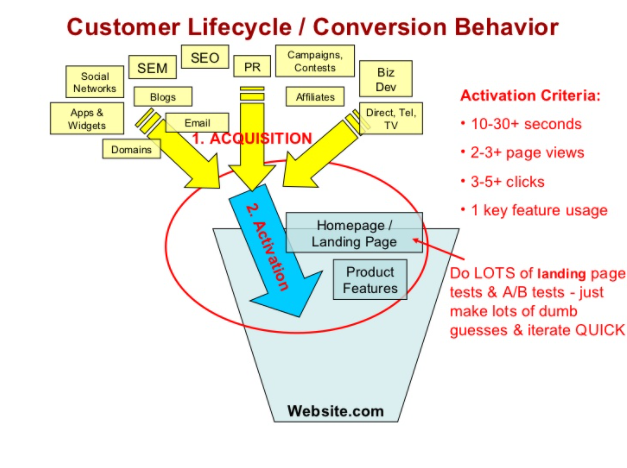⚓ This post is part of a blog series, “Here Be Metrics,” breaking down the primary aspects of the so-called pirate metrics for growth marketing. Keep up with this series and others by subscribing to our blog!
Stepping aboard a ship that flew the jolly roger thrust you into work before the mast. The captains of these ships certainly knew how to show new scallywags what that work involved.
While the products and services that companies offer today are substantially more enjoyable than life aboard a pirate ship, the need to give newcomers a snapshot of what’s to come is still just as pressing. In today’s marketing pirate metrics lingo, we’re talking about activation.
Activation Brings Someone Aboard
Activation is the moment that a potential customer or client is brought on board. In other words, this is when a customer directly interfaces with a company’s product or service.
Whereas acquisition leverages content about a product or service to appeal to customers or clients and get them to, say, a landing page, activation means that potential client has spent some quality time/experience with your business to the point of taking the next step in the relationship. 😘
You're continuing to answer the million-dollar (we wish!) question: what moves a customer deeper into the sales funnel?
Activation Can Take Many Forms
Activation itself can take on many different forms, and its importance varies across industries. While it’s a main driver within the sales funnel in some industries, other industries make almost no use of activation.

Image Credit: 500 Hats
For example, the concession stand at a sports stadium doesn’t wait to hand out food samples until a customer buys their hotdog at halftime. The avid sports fan doesn’t get to experience their stadium food until after the sale is already made. After the customer has forked over their small fortune for a hotdog they get to determine whether the hotdog is worth the value they paid for it.

Luckily, hot dogs are always worth the money. But the same can’t be said for every transaction, and customers shopping online are wary about spending their money on a dud.
Let’s take a look at other examples of initiating activation within the customer lifecycle:
- A coffee roaster gives out free samples at a grocery store to gain new customers.
- An investment advisor gives individuals a free consultation, where they can get a purview of the advisors’ style and services.
- A book printer sends sample books to self-publishing authors, demonstrating the quality of their printed materials and showing different options.
- An online clothing store publishes videos and photos that illustrate fit for different body types so that a customer can envision themselves in the clothes.
- A subscription meal service provides a discount for one month of services to get the customer hooked on their flavors.
But activation could also be as simple as moving a customer through the sales funnel thanks to an engaging and user friendly website that motivates them to make a purchase. Think of this stage as the spark and action that moves a potential customer to become a paying customer.
Online Marketing and Activation Go Hand-in-Hand
 Image Credit: 500 Hats
Image Credit: 500 Hats
For many online marketers of service-based businesses, activation plays an especially large role within the sales funnel.
Many of these businesses rely on strategies like offering free trial periods for software programs or courses or freemium software that gives limited access to features to get viewers farther down the funnel.
Several Metrics Can Be Used to Monitor Activation
What metrics should be used to track activation depends on how a company approaches this stage. Similar to the sales funnel as a whole, the activation step of the customer lifecycle “drips” customers down from the early activation stage toward making a purchase.
Some common metrics that offer insights into activation:
- Landing page entrances
- Time spent on website
- Number of pages visited by an individual
- Sign-ups & sign-up conversion rates
- Product qualified leads (PQLs)
- Time from sign-up to purchase
Make Your Product or Service Available for Activation Steps
No matter how skillful your copywriters are (*ahem*) or how persuasive your salespeople are, there’s no substitute for trying out the real thing. Only those who worked before the jolly roger truly know what it was like to be a pirate on the high seas, and only those customers who try out a product or service really know what that’s like.

Get your product or service into customer’s hands or help them feel like they are experiencing the “real thing” whenever you can, so your company can show them the goods booty for real.


-AK-148968-preview.png?width=842&height=310&name=1.01-1x1px-Embertribe-(Client-Services)-AK-148968-preview.png)










 Image Credit
Image Credit
.png?width=810&height=810&name=TJ%20Jones%20-%20%20CoFounder%20EmberTribe%20(1).png)


%20-%20500x500%20-%20SP%20-%2045.01.png)
%20-%20500x500%20-%20SP%20-%2049.01.png)
%20-%20500x500%20-%20SP%20-%2057.01.png)


.png)